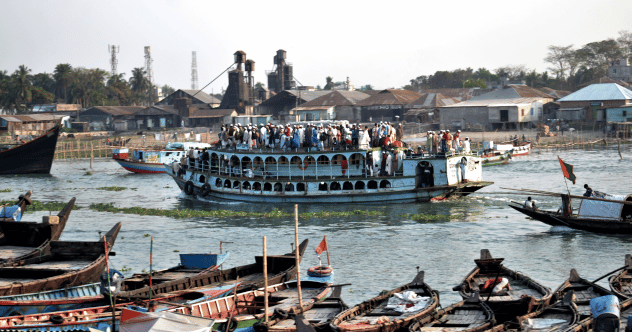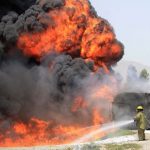 Weird Stuff
Weird Stuff  Weird Stuff
Weird Stuff  Our World
Our World 10 Ways Your Christmas Tree Is More Lit Than You Think
 Movies and TV
Movies and TV The 10 Coolest Stars to Set Sail on The Love Boat
 History
History 10 Things You Didn’t Know About the American National Anthem
 Technology
Technology Top 10 Everyday Tech Buzzwords That Hide a Darker Past
 Humans
Humans 10 Everyday Human Behaviors That Are Actually Survival Instincts
 Animals
Animals 10 Animals That Humiliated and Harmed Historical Leaders
 History
History 10 Most Influential Protests in Modern History
 Creepy
Creepy 10 More Representations of Death from Myth, Legend, and Folktale
 Technology
Technology 10 Scientific Breakthroughs of 2025 That’ll Change Everything
 Weird Stuff
Weird Stuff Ten Bizarre Facts About The Doge Meme
 Our World
Our World 10 Ways Your Christmas Tree Is More Lit Than You Think
 Movies and TV
Movies and TV The 10 Coolest Stars to Set Sail on The Love Boat
Who's Behind Listverse?

Jamie Frater
Head Editor
Jamie founded Listverse due to an insatiable desire to share fascinating, obscure, and bizarre facts. He has been a guest speaker on numerous national radio and television stations and is a five time published author.
More About Us History
History 10 Things You Didn’t Know About the American National Anthem
 Technology
Technology Top 10 Everyday Tech Buzzwords That Hide a Darker Past
 Humans
Humans 10 Everyday Human Behaviors That Are Actually Survival Instincts
 Animals
Animals 10 Animals That Humiliated and Harmed Historical Leaders
 History
History 10 Most Influential Protests in Modern History
 Creepy
Creepy 10 More Representations of Death from Myth, Legend, and Folktale
 Technology
Technology 10 Scientific Breakthroughs of 2025 That’ll Change Everything
Top 10 Horrific Accidents That Will Make You Thankful for Life
Have you ever had one of those days when you spilled your morning coffee and thought it was the end of the world? Well, buckle up because we’re about to take a wild ride through the top ten horrific accidents that’ll make you want to give life a big, thankful hug.
From near misses to jaw-dropping survival stories, this rollercoaster of chaos will have you appreciating every moment and thinking twice before complaining about that flat tire. So, grab your gratitude goggles because we’re diving headfirst into the crazy world of heart-stopping accidents that’ll make you cherish the chaos we call life.
Related: Top Ten Lesser-Known Tragic Disasters
10 Chornobyl Nuclear Disaster (1986)
The Chornobyl nuclear disaster of 1986 is a haunting event that demonstrated the catastrophic potential of nuclear power. On April 26, 1986, the No. 4 reactor at the Chornobyl Nuclear Power Plant in Ukraine exploded. The explosion released radioactive material into the atmosphere. The disaster resulted from a flawed reactor design and operator errors during a safety test.
The explosion claimed the lives of two plant workers immediately. It also led to a surge in cancer cases and other health issues in the surrounding areas. The fallout reached as far as Europe, causing widespread environmental and health issues. The city of Pripyat, once home to plant workers, became a ghost town overnight.
The Chornobyl disaster remains one of the worst nuclear accidents in history. It is a cautionary tale about the importance of safety measures in pursuing technological advancement. In the face of this event, we should be grateful for the stability and safety measures in our daily lives.
9 Bhopal Gas Tragedy (1984)
The Bhopal gas tragedy of 1984 is one of history’s most devastating industrial disasters. It reminds us of the devastating consequences of negligence. In the heart of India, a pesticide plant owned by the Union Carbide Corporation leaked deadly methyl isocyanate gas. It claimed thousands of lives and left a long-lasting impact on survivors.
The incident occurred due to poor safety measures and maintenance lapses. What was meant to bring prosperity to the region turned into a nightmare. As the gas swept through the city, it caused respiratory failure, blindness, and other severe health issues. The aftermath was horrendous. Estimates of the death toll range from thousands to tens of thousands.
The tragedy brought global awareness about industrial safety and the need for stronger regulations. Decades later, the scars of Bhopal linger. It underscores the importance of prioritizing human lives over corporate interests.
8 The Station Nightclub Fire (2003)
The Station Nightclub fire of 2003 is a horrifying reminder of the fragility of life in crowded places. On February 20, a rock concert at the Rhode Island nightclub turned tragic when pyrotechnics ignited flammable soundproofing foam. The fire spread rapidly, creating chaos as the overcrowded venue became a death trap. In just 5 minutes, 100 lives were lost, and over 200 people suffered injuries.
This horrendous accident exemplifies the unforeseen dangers lurking in our leisure activities. The event prompted widespread reevaluation of safety protocols in public venues, emphasizing the need for proper fire exits, sprinkler systems, and crowd management. Hopefully, the Station Nightclub fire will encourage more efforts to enhance safety in shared spaces.
7 Japan Airlines Flight 123 (1985)
Japan Airlines Flight 123 stands as one of the most chilling aviation disasters. It underscores the fragility of life. What started as a routine flight from Tokyo to Osaka became a nightmare. A fatal decompression occurred, tearing off the vertical stabilizer. The Boeing 747-SR spiraled out of control, crashing into the mountains near Gunma Prefecture.
Tragically, of the 524 people on board, only four survived. The cause was linked to a faulty repair seven years prior, revealing a depressing chain of events. The accident prompted improvements in aviation safety, with lessons learned about maintenance procedures and communication protocols. Air travel is unpredictable, and we need more to ensure the safety of passengers worldwide.
6 Deepwater Horizon Oil Spill (2010)
The Deepwater Horizon oil spill in 2010 was an environmental upset that left a permanent mark on our planet. Triggered by a blowout at the Macondo well, this spill unleashed an estimated 4.9 million barrels of oil into the Gulf of Mexico over 87 days. The devastating consequences impacted marine life, coastal ecosystems, and local economies.
The spill not only claimed the lives of 11 workers but also became the largest marine oil spill in history. The images of oil-soaked wildlife and polluted shores were a stark display of the consequences of industrial negligence. The environmental impact was felt for years, affecting fishing industries and causing long-term damage to the balance of Gulf ecosystems.
The Deepwater Horizon disaster spurred discussions about offshore drilling safety and the need for stricter regulations. It is a cautionary tale emphasizing the importance of responsible practices in our quest for energy resources.
5 Bangladesh Ferry Disaster (1994)

Dozens of rescue boats headed out to find survivors. Of the 250 on board, only 45 were pulled out alive. Passengers, mostly commuters and families, found themselves trapped as the vessel sank beneath the murky waters. They continued searching for several hours but were unable to locate anyone else. Unfortunately, this wasn’t the first ferry to be lost in Bangladesh waters and certainly wouldn’t be the last.
4 Fukushima Daiichi Nuclear Disaster (2011)
The Fukushima Daiichi nuclear disaster of 2011 was triggered by a massive earthquake and subsequent tsunami in Japan. It remains etched in history as it resulted in a disastrous meltdown of three reactors at the Fukushima Daiichi nuclear power plant. The meltdown released radioactive materials into the environment. The disaster not only claimed lives but also left a lasting impact on the region’s ecosystem.
The aftermath prompted widespread concerns about nuclear safety, leading many to reflect on the consequences of relying heavily on nuclear energy. The incident served as a wake-up call for reevaluating safety measures in the face of natural disasters. It also ignited global discussions on the risks and benefits of nuclear power. The Fukushima Daiichi disaster, though tragic, has spurred advancements in nuclear safety protocols.
3 Triangle Shirtwaist Factory Fire (1911)
The Triangle Shirtwaist factory fire of 1911 stands as a reminder of the need for workers’ rights and safety regulations. On March 25, 1911, in the heart of New York City, the garment factory became a blazing inferno. It claimed the lives of 146 workers, mostly young immigrant women, due to locked exit doors, inadequate fire escapes, and flammable materials scattered throughout the workspace. As the fire spread, workers faced a choice between burning alive or jumping from the ninth and tenth floors.
Thankfully, this terrible event fueled the labor movement, prompting widespread outcry for improved workplace conditions and safety standards. The fire led to significant changes in labor laws and fire safety regulations, making it a pivotal moment in American history. Through the Triangle Shirtwaist factory, we see how progress can arise from the worst circumstances.
2 Hindenburg Disaster (1937)
The Hindenburg Disaster of 1937 was a chilling spectacle that left a mark on air travel history. On May 6, the German passenger airship LZ 129 Hindenburg burst into flames while attempting to dock in Lakehurst, New Jersey. The once-promising era of luxurious transatlantic airship travel came crashing down, quite literally, in a fiery explosion witnessed by horrified onlookers. The 804-foot behemoth, filled with highly flammable hydrogen gas, succumbed to a tragic combination of electrical sparks and a flammable outer covering, turning a routine landing into a blazing inferno.
Of the 97 people on board, 36 lost their lives, and the shocking images of the Hindenburg engulfed in flames have since become iconic. The disaster spelled the end for commercial airship travel, as public confidence plummeted.
1 Kursk Submarine Disaster (2000)
The Kursk Submarine Disaster in 2000 is a terrifying example of the perils of underwater exploration. On August 12, the Russian nuclear submarine Kursk, armed with torpedoes, suffered a major explosion during a naval exercise in the Barents Sea. The tragedy claimed the lives of all 118 crew members on board. The initial blast, likely caused by a torpedo malfunction, was powerful enough to register on seismographs as far away as Alaska.
The subsequent rescue efforts were marred by communication failures and inadequate equipment, prolonging the agony for the trapped sailors. The world watched as Russia struggled to salvage the submarine, ultimately revealing the devastating loss. The Kursk Disaster prompted international scrutiny of Russian naval practices and safety protocols. There is an inherent risk in pursuing scientific and military endeavors beneath the waves.








